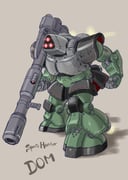space harrier
Space Harrier (スペースハリアー Su-pē-su Ha-riā) is a third-person science fiction and fantasy rail shooter video game, released by SEGA in 1985. It was produced by Suzuki Yu , responsible for many popular and innovative Sega games.
Space Harrier was ported to various home computer systems and consoles. Among the home versions, the ports for the Sega 32X, the Sega Saturn and the Sharp X68000 (the latter being a Japan-only release) are considered to be the most faithful to the original arcade version.
The game also spawned several sequels: Space Harrier 3-D (1988) for the Sega Master System, Space Harrier II (1988) for the Sega Mega Drive, and the arcade spin-off Planet Harriers (2000).
Space Harrier was one of the first arcade games to use 16-bit graphics and Sega's "Super Scaler" technology that allowed pseudo-3D sprite-scaling at high frame rates, with the ability to scale as many as 32,000 sprites and fill a moving landscape with them, along with over 32,000 colours displayed simultaneously on the screen.
It also introduced a true analog flight stick for movement, with the ability to register movement in any direction as well as measure the degree of push, which could move the player character at different speeds depending on how far the stick is pushed in a certain direction.
The game was also an early example of a third-person shooter; it was influenced by the earlier 1982 Sega game Buck Rogers: Planet of Zoom, and Space Harrier in turn influenced later 3D shooters such as Nintendo's Star Fox (1993).
See also
- Fantasy Zone - Another SEGA game set in the same fictional universe.



